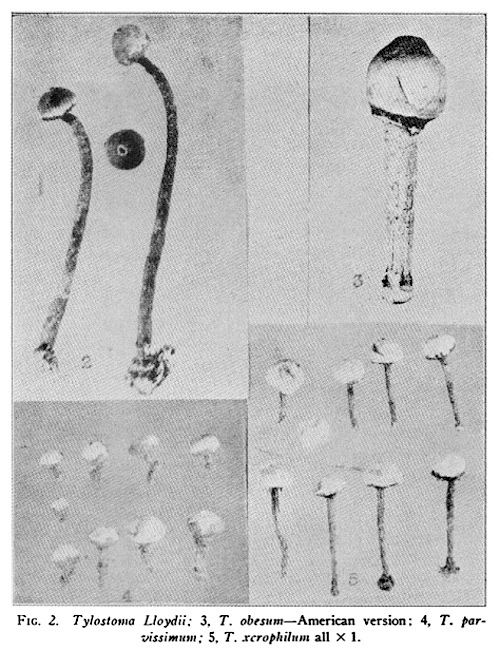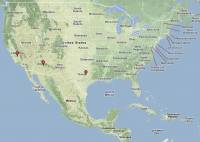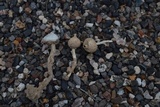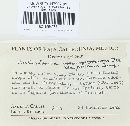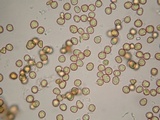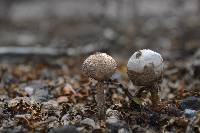
|
|
|
|
Family: Agaricaceae
|
Long W.H. 1946. Mycologia 38: 85. Tylostoma xerophilum sp. nov. Fig.5. Latin diagnosis: Sporocarpo globoso usque depresso-globoso, 4-5 mm. alto, 6-8 mm. lato. Exoperidio membranaceo, brunneo, toto secedente. Endoperidio toto levi, papyraceo, albo. Ore regulari integro, prominenti,. mammoso, minuto. Stipite tenui, 15-25 mm. alto, 2-3 mm. crasso, brunneq. Sporis subglobosis, 4-5r. Episporio granuloso, fulvo. Sporophore consisting of sporocarp and stipe. Sporocarp sub-globose to depressed-globose, 4-5 mm. high by 6-8 mm. wide, firmly attached to stem apex. Exoperidium strongly and permanently membranous, outer surface walnut brown covered with a sandy layer, inner surface white, drying to a thin, very fragile membrane deciduous in flakes, leaving lacerate shreds of dried membrane around top of the peridial sheath. Peridial slzeath a thin membranous band under the head, 3-4 mm. wide, with an irregular border, semi-decidtious. Endoperidium white, perfectly smooth, papyraceous. Mouth tubular, small, circular, prominent. Collar inconspicuous, close to stem. Stipe very slender, weak, easily breaking especially near base, straight, uniform, 1 1/2 - 2 1/2 cm. long by 2-3 mm. thick, often striate on part above ground, smooth below, pecan brown. Volva none. Radicating base none. Gleba cinnamon color. Capillitium hyaline, same diameter as spores, septa slightly swollen. Spores subglobose, 4-5 u in diameter. Epispore sayal brown, minutely verruculose. Habit: Solitary or in small groups in partial shade, in mesquite-catclaw flats (Prosopis-Acacia). Distribution: ARIZONA, SANTA CRUZ COUNTY, 7 miles from Nogales on state highway 89, elevation 3857 feet, W. H. Long and Victor 0. Sandberg, November 13,1936, 8847 (7plants). W.H. Wright J.E. 1987. Bibliotheca Mycologia 113: 215. Tulostoma xerophilum Long. (Fig. 155; Pl. XXV:4) Mycologia 38: 85-87, fig. 5. 1946. Etym.: The name refers to the xerophilous habitat of the species. Spore-sac globose to slightly globose-depressed, up to 10 mm diam on the average, mostly 7-9 mm; well adhered to the stem. Exoperidium typically membranous, thick, very white within, dark brown to argillaceous outwardly, persisting at the base where it is usually agglutinated with sand particles, and sloughing off in large scales or pieces which may even remain recurved on the stem. Endoperidium finally smooth, almost white to slightly ochraceous, very smooth and clean once the exoperidium has fallen off. Mouth tubular, slightly projected to plane, with a darker peristome in some specimens, or cinereous. Socket inconspicuous, deep, not separated from the stem, with a thick and entire membrane. Gleba light ochraceous to ferrugineous. Stem up to 35 x 2 mm, fragile, rugose-scaly, slightly attenuated towardst e base, where it becomes almost discoid; concolorous with the exoperidium or somewhat lighter (light brown to ferrugineous), slightly striate in the middle portion or upper third, sometimes contorted. Endoperidium formed by septate, hyaline threads swollen at the colourless septa, somewhat more slender than those of the capillitium. Spores globose to elliptic, minutely asperulate under L.M., coloured (yellowish under medium power), 3.6-5.9 µm diam, apiculate, with a relatively large guttula when observed in KOH solution. Under SEM, the ornamentation appears formed by a sort of cracked surface covered here and there with uneven scant verrucae, some anastomosed, as if they were remains of an outer layer. Capillitium branched, septate, subhyaline; threads thick-walled, lumen visible to scant, sometimes constricted or lacunar, with scarce to frequent, slightly swollen septa, disjointable; some with hyaline incrustations or lens-like isolated deposits. Habitat: typically inhabiting sandy soils in arid or desertic regions; solitary or in small groups in the shade of Prosopis-Acacia vegetation. Distribution: North America: United States (Arizona, California, Texas); Mexico. Holotype: United States: Arizona, 7 mi from Nogales, on Hway 89, leg. Long & Stouffer, 13.XI.1936 (Herb. Long 9688, BPI!). Illustration: Long (op. cit.). |

